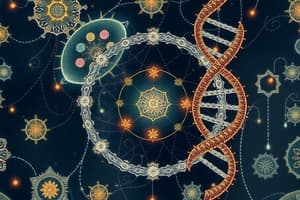Podcast
Questions and Answers
What is the main purpose of cell division?
What is the main purpose of cell division?
- Elimination of waste
- Growth and repair of tissues (correct)
- Storage of nutrients
- Production of energy
Mitosis creates four genetically identical daughter cells.
Mitosis creates four genetically identical daughter cells.
False (B)
Name the three phases of interphase.
Name the three phases of interphase.
G1, S, G2
During meiosis, genetic variation arises from ______ and independent assortment.
During meiosis, genetic variation arises from ______ and independent assortment.
Match the stages of meiosis with their primary actions:
Match the stages of meiosis with their primary actions:
Flashcards are hidden until you start studying
Study Notes
Cell Division Purpose
- Cells divide for growth, repair, and reproduction.
DNA Structure
- DNA is a double helix made of nucleotides.
- Each nucleotide consists of a sugar, a phosphate, and a nitrogenous base.
- The bases are adenine (A), thymine (T), guanine (G), and cytosine (C).
- A pairs with T, and G pairs with C.
Cell Cycle Stages
- Interphase: The stage where the cell grows and copies its DNA.
- G1: The cell grows and carries out normal functions.
- S: DNA replication occurs.
- G2: The cell prepares for mitosis.
- Mitosis: The stage where the nucleus divides.
- Prophase: Chromosomes condense and become visible.
- Metaphase: Chromosomes line up at the equator of the cell.
- Anaphase: Sister chromatids separate and move to opposite poles.
- Telophase: Nuclear membranes form around the chromosomes, and the chromosomes uncoil.
- Cytokinesis: The stage where the cytoplasm divides.
Meiosis Stages
- Meiosis I: The first division, where homologous chromosomes pair up and separate.
- Prophase I: Chromosomes condense, crossing over occurs.
- Metaphase I: Homologous chromosome pairs line up at the equator.
- Anaphase I: Homologous chromosome pairs separate.
- Telophase I: Two daughter cells form, each with half the number of chromosomes.
- Meiosis II: The second division, where sister chromatids separate.
- Prophase II: Chromosomes condense again.
- Metaphase II: Chromosomes line up at the equator.
- Anaphase II: Sister chromatids separate and move to opposite poles.
- Telophase II: Four haploid daughter cells form.
Mitosis vs. Meiosis
- Similarities: Both involve DNA replication and division.
- Differences: Mitosis produces two identical diploid daughter cells. Meiosis produces four genetically different haploid daughter cells. Mitosis occurs for growth and repair, while meiosis occurs for gamete production.
Gametogenesis
- Spermatogenesis: The process of producing sperm cells.
- Occurs in the testes.
- Each sperm cell has a tail for movement.
- Oogenesis: The process of producing egg cells.
- Occurs in the ovaries.
- One egg cell is produced per cycle, along with polar bodies.
Genetic Variation
- Crossing Over: Exchange of genetic material between homologous chromosomes during prophase I.
- Independent Assortment: Random segregation of homologous chromosomes during metaphase I.
Errors in Meiosis
- Chromosome Structure: Deletions, duplications, inversions, translocations.
- Chromosome Number: Aneuploidy (extra or missing chromosomes).
Glossary of Terms
- Make a glossary of important terms for review, including DNA structure, stages of cell division, gametogenesis, genetic variation, and errors in meiosis.
Studying That Suits You
Use AI to generate personalized quizzes and flashcards to suit your learning preferences.





